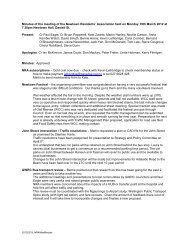Draft Town Belt Management Plan - Wellington City Council
Draft Town Belt Management Plan - Wellington City Council
Draft Town Belt Management Plan - Wellington City Council
Create successful ePaper yourself
Turn your PDF publications into a flip-book with our unique Google optimized e-Paper software.
5.5 Policies<br />
Protecting the biodiversity of the <strong>Town</strong> <strong>Belt</strong><br />
5.5.1 The <strong>Council</strong> will identify and restore all ecologically important areas on the <strong>Town</strong> <strong>Belt</strong>.<br />
5.5.2 The <strong>Council</strong> will protect all streams and natural water courses on the <strong>Town</strong> <strong>Belt</strong>.<br />
5.5.3 The <strong>Council</strong> will protect the natural structure and flow of streams on the <strong>Town</strong> <strong>Belt</strong> from<br />
modification, and restore them where possible.<br />
5.5.4 Where there is existing infrastructure, including stormwater management devices, within<br />
the <strong>Town</strong> <strong>Belt</strong> these will be managed and if necessary redesigned to minimise impacts on<br />
the natural environment.<br />
5.5.5 The <strong>Council</strong> will continue to recognise and manage <strong>Town</strong> <strong>Belt</strong> forest (exotic and<br />
indigenous) for its carbon absorption through programmes such as the Emissions Trading<br />
Scheme.<br />
Restoration<br />
5.5.6 Indigenous habitat restoration work carried out by the <strong>Council</strong> will be prioritised around:<br />
a. ensuring the ecological connectivity of the <strong>Town</strong> <strong>Belt</strong> and adjacent reserve land<br />
b. enhancing the species diversity of the <strong>Town</strong> <strong>Belt</strong><br />
c. replacing exotic trees removed as part of a hazardous tree removal programme.<br />
5.5.7 Where there is a significant barrier to fish passage in a section of stream flowing through<br />
the <strong>Town</strong> <strong>Belt</strong>, the fish passage shall be restored as resources allow.<br />
5.5.8 The <strong>Council</strong> will encourage and support local communities and interested groups to develop<br />
and implement restoration plans for the <strong>Town</strong> <strong>Belt</strong> consistent with these policies.<br />
5.5.9 All restoration work to native forest shall be carried out with eco-sourced plants.<br />
5.5.10 The <strong>Council</strong> will support community revegetation, restoration and education programmes<br />
in accordance with the Biodiversity Action <strong>Plan</strong> (2007).<br />
Increasing indigenous vegetation cover<br />
5.5.11 Continue with the vegetation priority and removal plan based on stand stability and risk<br />
assessment of exotic vegetation.<br />
5.5.12 Identify areas, as part of this removal plan, suitable for restoring indigenous vegetation<br />
cover in each sector.<br />
5.5.13 Revegetation priorities will be based on:<br />
• representativeness – an assessment of the characteristic (natural) vegetation and<br />
habitats of an area<br />
• rarity – an ecosystem type in a locality that does or could support a rare or threatened<br />
species<br />
• connectivity and buffering – area provides connectivity between fragmented indigenous<br />
habitats, buffers or enhances ecological values of a specific site of value, or provides<br />
seasonal or core habitat for specific indigenous species<br />
• diversity/special features – diversity of ecological units, ecosystems and physical<br />
features within a natural area.<br />
<strong>Draft</strong> <strong>Town</strong> <strong>Belt</strong> <strong>Management</strong> <strong>Plan</strong> October 2012 39





